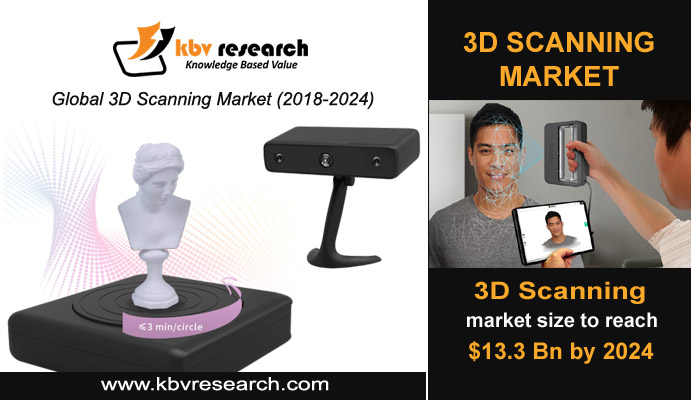3D Scanning is an Emerging and Realization Technology
3D Scanning has emerged as modern technology to analyze
real-world objects to collect data on their appearance. Demands are growing and
applications are also growing. 3D Scanning
helps to understand how complex parts and shapes work and helps develop a
better product. 3D scanners are an ace technology for maintaining a high degree
of automation of quality assurance.
 |
| Global 3D Scanning Market (2018-2024) | KBV Research |
What is 3D Scanning?
3D scanning is a technique used to capture the shape of an object using a 3D scanner. The result is the 3D file of the object that can be
saved, edited, and even printed in 3D. For 3D scanning objects, environments, and people, there are several different 3D scanning technologies available. Each 3D scanning technology has its own limitations, benefits, and costs.
3D laser scanners evaluate intricate details and capture free-form shapes to quickly produce highly accurate point clouds. 3D laser scanning is designed especially for measuring and inspecting contoured surfaces and complex geometries requiring large amounts of data for their accurate description and wherever it is impractical with the use of traditional measuring methods or a touch probe.
Why do we need 3D
Scanning?
Due to the ongoing technological revolution, various imaging applications have emerged on the market. 3D scanners are a key element in the overall value chain to enhance printing applications and sophisticated imagery. Laser 3D scanning is well known and is being used exponentially in the entertainment and media industries. End-users have been able to use scanning in industries such as civil infrastructure, mining, construction and entertainment through comprehensive technology development.
3D scanning technology is immensely useful while preserving and maintaining historical sites and monuments. High-precision optical scanners or laser scanners enable fine details to be recorded for an object. Such recordings are effective in maintaining the reference of an object. It also helps to identify any sculptural or structural damage or deformation. 3D scanning technology offers the advantage of sophisticated site maintenance that offers superior quality inspection.
Advantages of
implementing the 3D Scanning technology:
3D scanning can be applied in the design phase by starting with a physical object and using it to design a CAD model. Designers often need to design around or adapt their design to existing objects. These parts can also be scanned and incorporated into the design, resulting in consistently better fitting parts. New designs can incorporate and improve engineering optimization already inherent in the manufactured part by using reverse engineering.
Click Here For Free Insights: https://www.kbvresearch.com/news/3d-scanning-market/
3D scanning can also be used to capture tool changes or parts that occur on the shop floor. Manual modifications and optimizations can be transferred from tool to tool using 3D scanning to ensure that all manufactured parts match after production. 3D scanning can be used to analyze
and characterize tool wear during production and to predict or remove tool failure when used correctly. In case a tool fails to work, 3D scan data can be used to recreate the optimized part.
Trends and Prospects
In the research work undertaken in the medical field of 3D scanning applications, there is an increasing trend, which also explains future potential and contribution. Companies are exploring 3D scanning for commercial medical applications along with part analysis and designs prior to actual production. It helps to quickly and easily create efficient implants.
The main reason for implementing 3D scanning in the medical field is because it captures accurate surface data which can be used for research and development purposes. Fast, reliable, comfortable and precise, which helps to improve and increase the effectiveness of specialized processing
systems. Because of its wide availability and ease of use, 3D scanning technologies are expected to capture a much larger market share.
For online retailers, customer fit issues require adequate stock planning as well as the margin-shrinking costs of roundtrip shipping. However the emerging 3D body scanning technology - which would allow consumers to use cameras and lasers on their mobile devices to capture accurate body
measurements - could solve both problems. The wide adoption of this technology could imply a decisive shift in the global apparel market, causing it to move much more extensively online, bringing better revenues and margins to online retailers - and adding brick-and-mortar pressures. The worldwide 3D Scanning Market is predicted to flourish at a CAGR of 18.4% over the near future.



Comments
Post a Comment